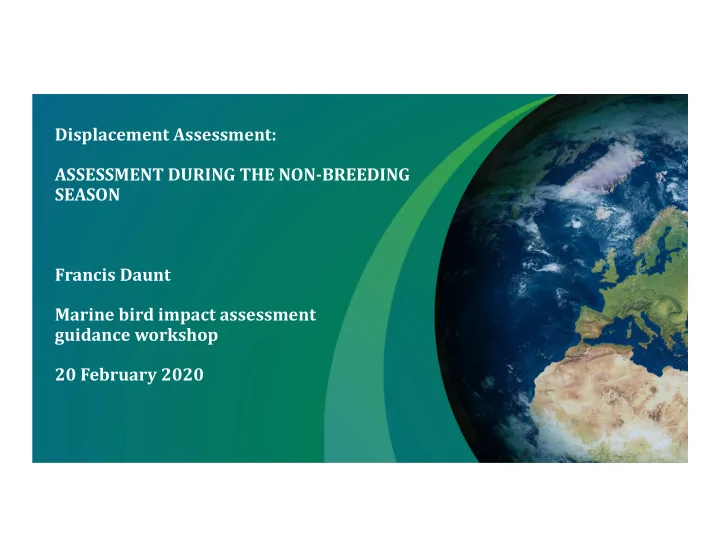

Displacement Assessment: ASSESSMENT DURING THE NON ‐ BREEDING SEASON Francis Daunt Marine bird impact assessment guidance workshop 20 February 2020
Displacement in the breeding and non-breeding seasons • Marked differences in the ecology of seabirds during the breeding and non-breeding season • Data quality is much poorer in non-breeding season, but this is improving • Non-breeding season is of critical importance: - Important populations of most key species in most regions - Most mortality occurs in winter
Breeding season Operating out of a central place • High energy demands of breeding • Spatially constrained • Temporally constrained • Life history theory: trade-off between current and future reproduction • Marked variation in productivity •
Non-breeding season Adult birds are independent of offspring and mates • Not typically operating out of a central place • Partial or full migration in winter • High energetic costs in midwinter • Spatially constrained e.g. flight costs • Temporally constrained e.g. day length • Birds are less constrained than breeding season • Less marked variation in survival than productivity in most seabirds •
Current approach Density from at-sea survey data • Apportioning and seasonal • definitions from BDMPS Mortality rates from • Displacement Matrix Joint Statutory Nature Conservation Bodies (SNCB) Interim Displacement Advice Note (2017)
Limitations of current approach Density in footprint Apportioning to SPAs x Displacement rate x Mortality rate Expert judgement
Limitations of current approach Summer and winter effects are estimated separately and then summed • - Summer effects on survival mediated by changes in body mass - Subsequent mortality in the non-breeding season - Potential for double counting winter mortality Relevant to: • - Summer Displacement Matrix / Winter Displacement Matrix - Summer SeabORD / Winter Displacement Matrix
Limitations of current approach Laying date Subsequent effects on productivity ignored • 8 Winter foraging effort 7 Daily foraging time (h) Breedmg success 6 5 4 3 Laying date Sep Oct Nov Dec Jan Feb Mar Apr Daunt et al (2014) Ecology
Potential approaches Key priorities: • - Interaction between birds of known provenance and footprints during the non-breeding season - Defensible estimates of mortality rate of displaced birds - Avoidance of double counting in assessments - Incorporation of carry-over effects on subsequent breeding Potential solution: • - Improved estimates of apportioning - Year-round model of behaviour, energetics and demography
Improved estimates of Apportioning Lila Buckingham
Year-round model of displacement Year-round model of daily intake rate and energy expenditure • Factor in key constraints arising from habitat loss: • - Spatial: flight costs - Temporal: seasonal daylength and energetic costs Estimate effects on demography: • - Survival - Subsequent breeding performance
Population-level approach Population-level approach: • - Distributions of species - % time in an area without needing to account for turnover - % habitat loss - Effects of mortality Potential advantages: • - Where there are limited individual data on year-round activity and energetic constraints - More rapid than individual-based approaches - Likely to provide justification for IBMs in cases where effects may be occurring
Individual-based approach IBM is more powerful but data hungry. • Current potential in guillemots where there are year-round data on: - Distribution - Activity/energetics - Body mass • Good understanding of requirements to plug data gaps: - GLS deployments in new species to build baseline IBMs - GPS deployments in new species to estimate interactions with developments
Conclusions on future assessments Current approaches lack biological realism • Non-breeding season effects are occurring at a critical time • Need empirical studies to fill data gaps • Need year-round models of behaviour, energetics and demography to estimate: • - Interactions between birds and developments - Effects on survival - Effects on subsequent breeding
Recommend
More recommend